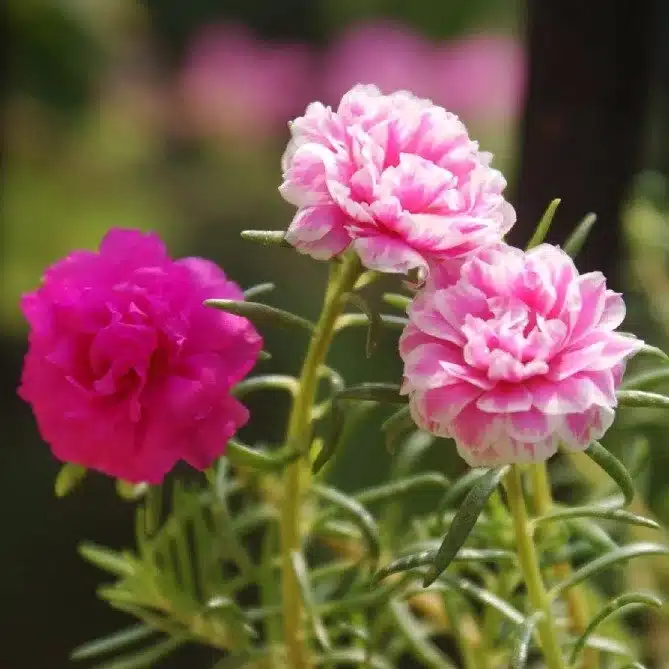The Ten O’Clock Plant is commonly known as the Portulaca, or more commonly as the moss rose, sun rose, or ten o’clock plant. It is a flowering succulent that is native to South America but is now widely cultivated as an ornamental plant in many parts of the world, including Vietnam.

Why it is called the 10 o’clock plant?
The name “ten o’clock plant” comes from the fact that the flowers of this plant usually open up fully in the morning, around 10 o’clock, and then close up again in the afternoon. The plant is prized for its bright, showy flowers, which come in a wide range of colors, including pink, red, orange, yellow, white, and purple.
In Vietnam, the ten o’clock plant is often grown as a ground cover or in hanging baskets, where its trailing stems and colorful flowers make it a popular choice for adding color to gardens and outdoor spaces.
Varieties of Portulaca Grandiflora
The most common species of Portulaca plant is Portulaca Grandiflora which has many varieties with different colors and growth habits. Here are some common Portulaca grandiflora varieties:

- ‘Fiesta’ – This variety has brightly colored flowers in shades of orange, yellow, pink, and red.
- ‘Tequila’ – This variety has double blooms in shades of pink, rose, and yellow.
- ‘Sundial’ – This variety has large, single flowers in shades of red, pink, yellow, and white.
- ‘Pazazz’ – This variety has ruffled, semi-double flowers in shades of pink, red, and yellow.
- ‘Carnival’ – This variety has semi-double flowers in shades of pink, rose, yellow, and white.
- ‘Happy Hour’ – This variety has large, ruffled flowers in shades of pink, yellow, orange, and red.
- ‘ColorBlast’ – This variety has bright, vivid flowers in shades of pink, red, orange, and yellow.
These are only a few of the several Portulaca grandiflora cultivars that are offered. Each variety has its own unique characteristics, so you can choose the one that best suits your gardening needs and preferences.
Benefits of 10 o’clock plant (Portulaca)
Portulaca, or the ten o’clock plant, has several benefits:
- Attractive Flowers: The most obvious benefit of Portulaca is its beautiful, brightly colored flowers. The plant is often used as an ornamental plant in gardens and hanging baskets, adding a splash of color to any outdoor space.
- Drought Tolerance: Portulaca is a drought-tolerant plant that can survive in hot, dry conditions with minimal water. This makes it a great choice for xeriscaping or for areas where water is scarce.
- Low Maintenance: This 10 o’clock plant is easy to grow and requires very little maintenance. It doesn’t need to be fertilized often and doesn’t require pruning, making it a low-maintenance option for gardeners.
- Edible: The leaves and stems of the plant are edible and can be used in salads or as a garnish. They have a slightly tangy flavor and are rich in vitamins A and C.
- Medicinal Uses: In traditional medicine, Portulaca grandiflora has been used to treat various ailments such as headaches, inflammation, and fever. Some studies have also shown that the plant has antioxidant and anti-inflammatory properties.
Overall, Portulaca grandiflora is a beautiful and versatile plant that can be used for ornamental, culinary, and medicinal purposes.
Common FAQs
Q1: What is the ideal growing environment for the 10 o’clock plant?
This plant thrives in hot and sunny conditions with well-drained soil. It’s a drought-tolerant plant that can survive in areas with low rainfall. If you live in an area with high humidity or frequent rainfall, it’s recommended to plant the Portulaca in a raised bed or container to ensure good drainage.
Q2: How often should I water my Portulaca Plant?
The Portulaca is a drought-tolerant plant and doesn’t require frequent watering. Watering once a week is usually sufficient, but if the plant is in a container or raised bed, it may require more frequent watering. Be careful not to overwater the plant, as this can cause root rot.
Q3: Can I grow a 10 o’clock plant indoors?
No, This plant is an outdoor plant that requires direct sunlight and well-drained soil. It’s not recommended to grow it indoors, as it may not receive enough sunlight and can develop fungal diseases due to the lack of airflow.
Q4: Are there any pests or diseases that affect the Portulaca (10 o’clock plant)?
The Portulaca is generally a disease-resistant plant and doesn’t have many pest problems. However, spider mites and aphids can sometimes infest the plant, especially in hot and dry conditions. To prevent pest infestations, it’s recommended to keep the plant well-watered and to prune any affected leaves or stems. If the infestation is severe, you can use an insecticidal soap or neem oil to control the pests.
